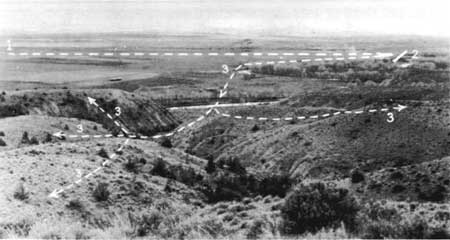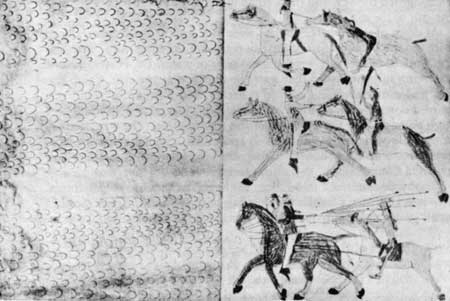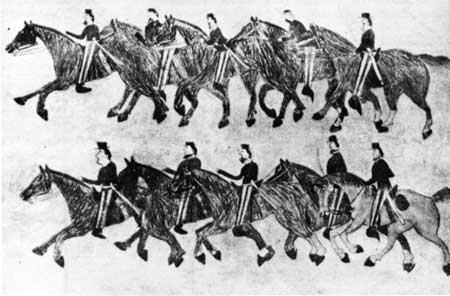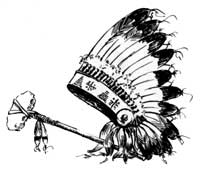|
LITTLE BIGHORN BATTLEFIELD National Monument |
 |

Scene of Reno's engagement. 1. Reno's
advance. 2. Line of battle. 3. Retreat to the bluffs.
(Photograph by K. F. Roahen, Billings, Mont.)
Reno Battle Renewed by the Indians
After Reno's retreat to the bluffs and the Indians' retirement to the north to fight Custer, the roll for Reno's command was called. There were absent 3 officers and more than 40 men, including a few civilians. How many were wounded, hiding, or killed no one knew. The troopers with Reno had numbered 112, as well as 20 or more Arikara scouts, 3 or 4 Crow scouts, 3 white scouts, and 1 Negro listed as an interpreter.
Benteen with his three companies had seen no action as yet, for he had swung to the left to scout the country as ordered. Finding that the bluffs were almost impassable and that his horses were fast wearing out, he swung back to the trail. About 3 o'clock a messenger from Custer met him. Sergeant Kanipe, of Company C, brought orders to Captain McDougall to hurry up the pack train. The sergeant was smiling, and, as he passed on his way to the pack train, he called out "We've got 'em boys." Soon after, another messenger arrived, Trumpeter Martin of Company H, on duty as orderly trumpeter to Custer. He bore a hastily scrawled message from Lieutenant Cooke, Custer's Adjutant. "Benteen—Come on—Big village—Be quick—Bring packs. W. W. Cooke. P. S. Bring pacs." Indicating how urgently Custer then wanted his reserve ammunition, Cooke had added the postscript, "Bring pacs." Martin had been fired upon during his ride, and his horse was wounded; but he also was elated, telling Benteen that the Indians were "skedaddling" and that Custer was charging the village. Increasing the gait, Benteen pushed forward and joined forces with Reno, whose command was depleted and unnerved as they had just gained their defensive position on the high bluffs. An hour or so after Benteen arrived at this point, Captain McDougall came up with his company and the train of pack mules.

Illustration—"Soldiers Charging Indian Camp." Drawn by the
Sioux Chief Red-Horse.
(From the Tenth Annual Report of the Bureau of Ethnology,
Smithsonian Institution.)

Illustration—"Sioux Charging Soldiers." Drawn by the Sioux Chief
Red-Horse. This represents the retreat of Reno's battalion from the valley.
(From the Tenth Annual Report of the Bureau of Ethnology, Smithsonian Institution.)
Officers immediately conferred on what action to take. Reno's retreat had done considerable damage to the morale of the remaining men. Benteen's men felt more confident, naturally, as they had not engaged the Indians.
While the combined command was being organized, heavy and continuous firing was heard from down the river, evidently from the Custer engagement. Believing that Custer's troops might need assistance, Captain Weir started with Company D in the direction of the firing. Captain Benteen and the other two companies of his battalion followed Weir, and soon the remaining troops prepared to follow. When Weir reached a high point about a mile and a half to the northeast (now referred to as Weir Point) he saw a field of action several miles beyond. Indians were moving about on the field and appeared to be shooting at the ground. Owing to the distance, nothing else was distinguishable. This later was found to be Custer's battlefield, and perhaps at that time Custer and all his men were dead.

When the Indians observed the troops' approach from the distance, they began a frantic ride to cut them off. Soon warriors were near at hand, and it was necessary to dismount and prepare to fight on foot. Lines were thrown out and a stand made at this point. However, there were difficulties back of the line. It was impossible to bring up the wounded, and the pack mules had become scattered. Considering the advantages of the first position over the one now commanded and also in an effort to bring all the forces into a more compact body, orders were given to withdraw. No sooner had this operation been completed, than Indians appeared from everywhere. Lines were thrown out for defense, and heavy firing continued until dark, when the warriors withdrew to the valley.
During the night an effort was made to prepare for the return of the Indians which was expected with the coming daylight. The three or four spades and shovels were used to dig rifle pits and trenches. Some men waited their turn for the shovels, while others used knives, tin cups, or mess kits to dig protections for themselves. Ammunition cases and hard tack boxes were piled up for barricades. Occasionally, men would wander to the packs to obtain hardtack or raw bacon to allay their hunger. Meanwhile, a wild celebration was in progress in the Indian encampment. Fires lighted the sky, and the weird sounds of Indian chants penetrated the still of the night.
At dawn of the 26th, the Indians were back and the battle was resumed with renewed vigor. Most of the troopers were suffering from thirst, and the wounded especially were in great need of water. Dr. Porter, the one surviving surgeon, asked that water be obtained at any cost. Camp kettles and canteens were gathered together, and a group of volunteers moved down a deep ravine to the river. Four sharpshooters stood on a high point to draw the Indians' fire and also to protect the water carriers with their own fire. The move was successful, and the wounded were cared for. The 19 men who participated in this operation were later awarded Congressional Medals of Honor for this heroic action.
The battle continued throughout the forenoon and into the afternoon. It was at this time that the warriors began to withdraw, leaving only a small group to keep up occasional firing. Late in the afternoon, the Indians fired the grass in the valley, and when the cloud of smoke lifted the troops watched with relief the departure of the entire Indian encampment. The long procession of ponies and tepee pole travois went slowly trailing off toward the Bighorn Mountains, and before darkness enveloped them the last of the Indians had disappeared from sight.
About a dozen of the men who had been left behind by Reno's force during the flight from the valley on the afternoon of the 25th had hidden in the brush to prevent detection by the Indians. Some were able to gain the bluffs on the night of the 25th, but several were trapped until the night of the 26th, after the Indians moved off. During the 2 days, Reno and Benteen had lost 32 men killed and 44 wounded.
Apparently, all the Indians had departed, but the soldiers moved with great caution to avoid possible ambush by concealed warriors. The horses and mules were watered for the first time since before the battle started. A few men made fires for coffee, and the position on the bluff was moved slightly and strengthened.

|
|
Last Modified: Sat, Sep 28 2002 10:00:00 pm PDT |


